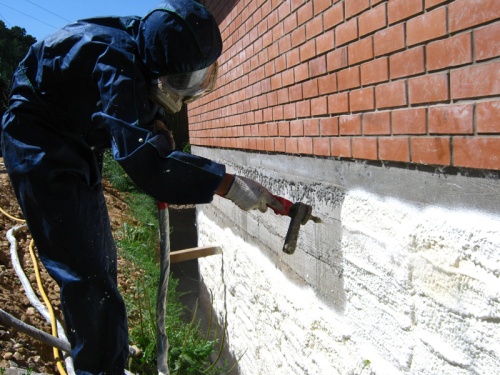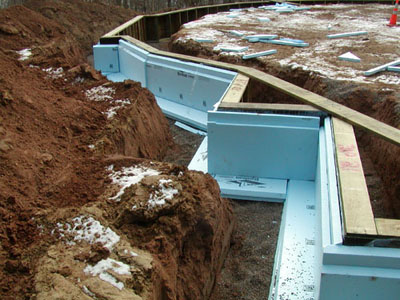As you know, the layout of many modern buildings implies the presence of a basement. If the basement is heated, then the owner should necessarily insulate the walls, otherwise heat will rapidly go to the ground through the foundation.
Content
What should I insulate the foundation?
If the foundation of the building remains without isolation, then the heat loss level can be up to 20% of the total amount of heat.
Basic freezing leads:
- to the emergence of mold in the basement;
- to the formation of dampness;
- to an increase in the cost of heating the premises.
At the same time, the main part of the soil in the middle band of Russia has a clay appearance and respectively refers to the bunny type. When thawing and freezing, it constantly changes the volume. Because of this impact on the foundation, deformation and the foundation displacement may occur. By external insulation of the walls there is a high probability to eliminate, or significantly reduce this impact.
In addition, most often the thermal insulation layer is applied over the waterproofing layer laid on the foundation. Thus, protection against mechanical damage is ensured during the reverse of the soil. As for the sole of the foundation, it is not isolated, because it is below the depth of the soil freezing.
Materials for insulation
For the external thermal insulation of underground elements, one of the following types of building materials are used:
- polyurethane foam;
- expanded polystyrene foam;
- Polystyrene foam extruded.
The properties that the foundation insulation should have:
- increased compression strength (in order to withstand the pressure of the soil);
- minimal water absorption level;
- Low thermal conductivity.
The insulation of the foundation of the foam
The insulation of the foundation of the foam from the outside is made using the following building materials:
1. Normal polystyrene foam
In order to create the insulation of the foundation of the foam outside, the foamed polystyrene (foam) is widely used today. This type of building material is manufactured in the form of plates.
The main advantages are:
- low thermal conductivity;
- low cost;
- Fighting the destructive effects of soil water, etc.;
- Used during seasonal freezing and soil swelling.
The standard location of the foam is the central part of the foundation blocks of three layers. If the foundation of the building has a basement of a monolithic type, then expanded polystyrene is used as a non-removable formwork. Thus, the costs of concrete are much reduced, there is a significant savings on fittings and labor costs.
The strength of the polystyrene polystyrene type is about 3 times less than that of the extruded and is 0.15 MPa at 10% of the deformation. However, in order to avoid reducing thermal insulation characteristics, it needs to be protected from the penetration of moisture and soil pressure.
Protection Recommendations:
- Additionally, from the outside, it should be closed by a brick wall or polyethylene profiled membranes;
- It is necessary to cover the waterproofing layer (rolled or bitumen-polymer).
2. Polystyrene extruded
The insulation of the foundation of the extruded foam foam is today the most common option. It has excellent compression strength (approximately 0.25-0.5 MPa during deformation of 10%) and low thermal conductivity.
High-quality extruded polystyrene foam has a homogeneous closed structure, which does not allow moisture to penetrate inside. Such a rather small level of water absorption ensures insulation increased frost resistance. The service life of this building material has up to 50 years.
The insulation of the foundation of the foam is extruded, the thickness of which varies from 30-120 mm, requires the calculation of thermal insulation works, taking into account the set of factors:
- climatic zone where construction is directly produced;
- Purpose of basement;
- Building materials and thickness of its walls.
For example, the basement must be warmed with such stoves with a thickness of about 5 cm. If you follow the basement, where it is planned to create a sauna or wine cellar, then it is better to apply the plates with a thickness of 10 cm. Along the corners of the structure you need to lay the plates from 6-10 cm, because Initially, they are precisely.
Insulation of the foundation of foam with his own hands
Foam insulation technology:
1. After the foundation is completely cast (either made from concrete blocks), a layer of waterproofing is applied to the outer surface. As it uses a resin based on bitumen or other similar building materials. Sometimes shear waterproofing is used, which is fixed on a special layer of adhesive or viscous waterproofing.
2. The next step is the outer laying on the foundation of the insulation. Since foam plates have different density, then for the foundation it is necessary to use the material with the highest density. Be sure to take care of additional protection that can be created from a brick or using a wooden "formwork".
3. The plates are mounted on the waterproofing of the bitumen resin or by mounting in the form of a "mushroom", fixing through the concrete wall. The foam is fixed close to each other for the entire depth of the foundation and without gaps.
4. After the plates are laid, they should be protected from the destructive pressure of the soil.
This can be done in the following ways:
- Create a layer of rubberoid between the soil and foam;
- Make a sandy pillow of about 10 cm.
Recommendations:
1. If the construction of your home has already been completed, then before starting to insulate the foundation of the polystyrene foaming outside, the deep trench should be pulled out along the insulated structure. Its width should be at least 1 m, the depth is determined by the size of the soil freezing. Next, technology is identical to the process described above.
2. To ensure the protection of the soil from the vertical freezing, already at the stage of construction of the breakfast around the house, on the bottom of the trench, after the gravel layer and the sand pillow, the plates of polystyrene foam should be laid, and then act according to the technology of the scene.
3. The insulation of the foundation of the house is best produced by the PSB-C foam. It has a type of sheet with different thickness and size. This type of building materials is quite convenient and beneficial during installation, as well as easy when transporting.
Thus, the fundamental insulation of foam is a wonderful way to make its housing dry and warm. You will forget about condensate, and will enjoy comfort and comfort for a long time.
Foam Foam Warming Technology Video:




























